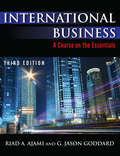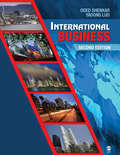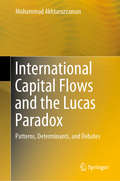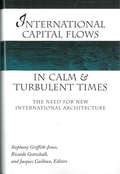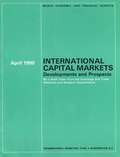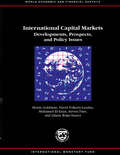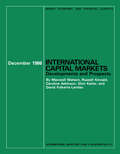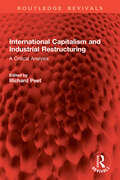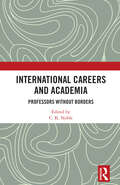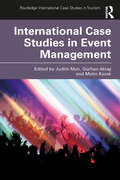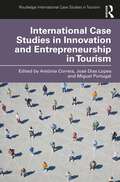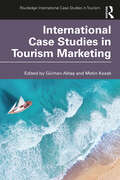- Table View
- List View
International Business: Theory and Practice
by Ehud Menipaz Amit MenipazWhat is international business? How does it differ from local or national business? What are the fundamental challenges and emerging trends in international business? What is the impact of globalization, corporate social responsibility, and the ever expanding use of digital technology on corporate strategies and executive decisions? International Business: Theory and Practice addresses these questions by providing the student with a broad overview of the subject, while guiding readers through the practical issues and context of international business with the use of a range of examples, cases and discussion questions drawn from around the world. Current critical issues in international business are analysed and explored: corporate social responsibility in an era of unprecedented globalization, the rise of the global entrepreneur and the `democratization′ of competition worldwide, and applications of technology in a digital economy. Key Features: - Unpacks the complex issues facing both multi-national enterprises (MNE) and international small and medium enterprises (SME) - Contains a full range of learning features including international case studies, explanations of key terms, a glossary, and annotated further reading
International Business: Theory and Practice
by Riad Ajami Jason G GoddardThe new and updated edition of this widely used text is equally useful for undergraduate and graduate students of international business. Its student-friendly format, detailed coverage of classic and timely topics, and extensive use of case studies make it widely adaptable for different level courses, as well as for educators who prefer either a case study or lecture approach. This edition features new coverage of the Asian financial crisis and the European Union. Its treatment of such topics as foreign exchange, international trade policy, and economic development introduces students to techniques for analysing national economies that are not covered in many competing texts. Ethical and environmental issues are also covered in detail, and all case studies, tables, and figures have been thoroughly revised and updated.Each chapter includes a short case study, while longer, more complex case studies conclude the text. Each chapter also features learning objectives, discussion questions, and references. An online instructor's guide that includes PowerPoints with end-of-chapter answers and maps is available to instructors who adopt the text.
International Business: Third Edition (International Business Ser.)
by Oded Shenkar Yadong Luop>Written by globally renowned scholars in the field of international business, International Business, Second Edition takes a truly global perspective that goes beyond the United States, presenting the latest concepts, tools and events, and adopting integrated and problem-solving approaches in every chapter. The book highlights the role of culture, politics and legal issues in international business and illustrates how they influence institutions, structures and processes that permeate all functions of business.
International Capital Crunches: The Time-Varying Role of Informational Asymmetries
by Mark P. Taylor Ashoka ModyA report from the International Monetary Fund.
International Capital Flows and the Lucas Paradox: Patterns, Determinants, and Debates
by Muhammad AkhtaruzzamanThis book offers a comprehensive analysis of the debates on international capital flows, and presents a new evidence-based answer to the long-standing question of why capital doesn’t tend to flow from rich to poor countries as predicted by standard neoclassical theory – a puzzle known as the Lucas paradox. Further, the book reviews alternative approaches to conventional estimates of the marginal product of capital (MPK) and considers whether these estimates actually help us understand observed international capital flows.A rigorous quantitative approach is subsequently used to provide clear empirical evidence on the determinants of capital flows across borders. The findings of this empirical analysis suggest that generous economic policies on capital account convertibility are more influential than differences in institutional quality in terms of determining international capital flows. In closing, the relative importance of various types of political risk (e.g. expropriation and corruption) is examined. After determining that expropriation risk has one of the greatest effects on foreign direct investment (FDI), the book proposes an appealingly intuitive explanation for the lack of FDI flows to many capital-scarce developing countries.
International Capital Flows in Calm and Turbulent Times
by Stephany Griffith-Jones Ricardo Gottschalk Jacques CaillouxInternational Capital Flows in Calm and Turbulent Times analyzes the financial crises of the late 1990s and draws attention to the type of lenders and investors that triggered and deepened the crises. It concentrates on institutional investors and banks and provides detailed analysis of the countries most affected by the 1997-98 Asian financial crisis as well as the Czech Republic and Brazil. It also suggests necessary international financial reforms to make crises less likely. The book is unique in its scrutiny of the type of lenders and investors that triggered and deepened the crises, focusing particularly on institutional investors and banks; allocation of their assets; the criteria used in this process; and the impact of the nature of the investor on the volatility of different types of capital flow. It addresses such questions as: What determines or triggers massive changes in perceptions and sentiment by different investors and leaders? To what extent does contagion spread not just among countries but between actors? What are the policy implications of this analysis? The book concludes by examining the asymmetries in the financial architecture discussions and implementation and by offering policy proposals.
International Capital Markets
by Donald Mathieson Maxwell Watson Russell Kincaid Eliot KalterThis report reviews and assesses recent developments in the mature and emerging markets and continues the analysis of key structural changes in global financial markets that has been presented in previous reports. The survey generally covers the 12-month period ending in June 2000. Over this period global financial conditions in the main improved in tandem with the strong rebound of the global economy. Credit concerns have eased following the most severe market turbulence in the post war period and global investors became more willing to engage in risk taking. The continued rapid growth of US productivity - largely related to the 'new economy' - helped sustain the low inflation expansion in the United States, and spurred US and worldwide investment. Chapters in the report focus on emerging market financing; private sector involvement in crisis prevention and resolution; the role of foreign banks in emerging markets.
International Capital Markets
by International Monetary FundThis report reviews and assesses recent developments in the mature and emerging markets and continues the analysis of key structural changes in global financial markets that has been presented in previous reports. The survey generally covers the 12-month period ending in June 2000. Over this period global financial conditions in the main improved in tandem with the strong rebound of the global economy. Credit concerns have eased following the most severe market turbulence in the post war period and global investors became more willing to engage in risk taking. The continued rapid growth of US productivity - largely related to the 'new economy' - helped sustain the low inflation expansion in the United States, and spurred US and worldwide investment. Chapters in the report focus on emerging market financing; private sector involvement in crisis prevention and resolution; the role of foreign banks in emerging markets.
International Capital Markets
by Theodore F. Peters Jr.A report from the International Monetary Fund.
International Capital Markets Developments and Prospects, 1982
by International Monetary FundA report from the International Monetary Fund.
International Capital Markets Developments and Prospects, 1983
by Donald J. Mathieson Peter Keller John LipskyA report from the International Monetary Fund.
International Capital Markets Developments and Prospects, 1984
by Maxwell Watson Donald J. Mathieson Peter KellerA report from the International Monetary Fund.
International Capital Markets Developments and Prospects, April 1990
by Augusto De la Torre Mark Allen Donald Mathieson Charles Collyns Mohamed Ei-Erian David Folkerts-Landau Tim Lane Liliana Rojas-Suarez Poul Thomsen Louis Pauly Can Demir Rosa Vera-BungeThis report presents the annual survey of international capital market developments and prospects. It reviews trends in the main market segments and seeks to analyze the principal forces underlying these developments, in particular the progressive integration of markets and the related globalization of investor and borrower behavior.
International Capital Markets Developments, Prospects, and Policy Issues
by International Monetary FundThis analysis of international capital markets is based on discussions with commercial and investment banks, securities firms, insurance companies, pension funds, stock exchanges, regulatory authorities, finance ministries, credit rating agencies and the Bank for International Settlement. It reflects information available up to the end of May 2001. The chapter headings are: developments and trends in mature capital markets; emerging market financing; the changing structure of the Major government securities markets; financial sector consolidation in emerging markets; staff appraisal
International Capital Markets: Developments and Prospects
by Augusto De la Torre Donald Mathieson David Folkerts-Landau Liliana Rojas-Suarez Louis Pauly Alessandro Leipold Mohamed El-Erian Juan Carlos Di Tata John Clark Steven FriesThis report reviews and assesses recent developments in the mature and emerging markets and continues the analysis of key structural changes in global financial markets that has been presented in previous reports. The survey generally covers the 12-month period ending in June 2000. Over this period global financial conditions in the main improved in tandem with the strong rebound of the global economy. Credit concerns have eased following the most severe market turbulence in the post war period and global investors became more willing to engage in risk taking. The continued rapid growth of US productivity - largely related to the 'new economy' - helped sustain the low inflation expansion in the United States, and spurred US and worldwide investment. Chapters in the report focus on emerging market financing; private sector involvement in crisis prevention and resolution; the role of foreign banks in emerging markets.
International Capital Markets: Developments and Prospects
by David Folkerts-Landau Maxwell Watson Russell Kincaid Caroline Atkinson Eliot KalterThis study assesses recent trends in international capital markets. It reviews, in particular, the forces currently reshaping the markets of industrial countries and confronting financial institutions with major challenges.
International Capital Markets: Developments, Prospects, and Key Policy Issues
by Garry J. Schinasi Donald J. MathiesonThis analysis of international capital markets is based on discussions with commercial and investment banks, securities firms, insurance companies, pension funds, stock exchanges, regulatory authorities, finance ministries, credit rating agencies and the Bank for International Settlement. It reflects information available up to the end of May 2001. The chapter headings are: developments and trends in mature capital markets; emerging market financing; the changing structure of the Major government securities markets; financial sector consolidation in emerging markets; staff appraisal
International Capital Markets: Recent Developments and Short-Term Prospects, 1981
by Richard C. WilliamsA report from the International Monetary Fund.
International Capitalism and Industrial Restructuring: A Critical Analysis (Routledge Revivals)
by Richard PeetFirst published in 1987, International Capitalism and Industrial Restructuring counters the idea that industrial restructuring is a relatively problem-free stage in the evolution to a post-industrial society. The editor argues that the permanent loss of eight million manufacturing jobs in the advanced industrial countries over the past ten years has had extremely serious effects on people, economies, and societies, and that it is a major cause of economic recession. The six million jobs gained in the newly industrializing countries pay low wages, expose workers to hazards, destroy local cultures, and fail in generating integrated development for the Third World.Many outstanding articles are included, drawn from a wide variety of radical journals, with introductions that set the scene and pose challenging questions. All students and researchers concerned with industrial restructuring in the capitalist world will find the book valuable as a radical critique of widespread current economic problems.
International Carbon Finance and EcoSecurities
by Andre F. Perold Forest Reinhardt Mikell HymanIn late 2007, EcoSecurities had to decide whether to undertake a new Clean Development Mechanism (CDM) project in China. EcoSecurities was an aggregator of carbon credits and also invested directly in projects that produced carbon credits. Governments and firms required to cut their greenhouse gas emissions under the Kyoto Protocol could use carbon credits to fulfill part of their compliance obligations. As demand for UN-issued carbon credits rose, the UN approval process had become increasingly burdensome. The Ventilation Air Methane Project was an opportunity to break into a new sector with large potential, and the economics and risks of the project needed to be assessed.
International Careers and Academia: Professors without Borders
by C. K. NobleWhile the topic of international careers and academia has received significant interest, the real contextual opportunities and barriers remain hidden by a dreadful reality across countries, contexts and international virtual spaces in greater numbers than ever before. This book integrates current debates of exposure to diversity and multiculturalism with different perspectives from authors with academic affiliations in 14 countries. It covers topics on intellectual, language and cultural diversity and offers a theory for the global value chain of academia and for the careers of international scientists. The aim is to achieve a holistic transformation with several possible courses of action useful to all involved in academia.The book also provides an overview of international scientific careers across different career stages based on lived experiences. This type of international geographical mobility needs more than supportive host institutions and requires international networks and relationships of trust.The book is a must-read for all involved in diversity and multiculturalism in higher education in different countries. It provides important insights to those engaged in academia and in international careers as scientists.
International Case Studies in Event Management (Routledge International Case Studies in Tourism)
by Metin Kozak Judith Mair Gürhan AktaşThis international case study book provides 27 expertly curated case studies on the topic of events management, each with detailed implementation instructions for the instructor in order to maximise student participation and learning. Embellished with questions, diagrams and data throughout, these case studies have been developed by industry experts and practitioners with the aim of creating a more interactive teaching experience focused on ‘real world’ scenarios within the events industry. Each case study is logically structured and includes an aim and objectives, expected learning outcomes, required background knowledge, steps of implementation in class or online, as well as suggestions for further reading resources. Topics covered range from macro impacts of events on destinations to success criteria in event operations, with the aim of preparing future professionals and equipping them with the necessary skills and competencies to succeed within the events industry. Easy to use and international in scope, this volume is an ideal study resource for use in higher and vocational education, and its unique, teaching-led approach positions it as a vital study tool for instructors and students alike.
International Case Studies in Food Tourism (Routledge International Case Studies in Tourism)
by Metin Kozak Gürhan Aktaş Aise KimThis international case study book provides 28 expertly curated case studies on the topic of food tourism, each with detailed implementation instructions for the instructor to maximise student participation and learning.Embellished with questions, diagrams and data throughout, these case studies have been developed by academic and industry experts with the aim of creating a more interactive teaching experience focused on 'real-world' scenarios within food tourism. Each case study is logically structured and includes an aim and objectives, expected learning outcomes, required background knowledge, steps of implementation in class or online, as well as suggestions for further reading resources. Topics covered range from locally oriented gastronomy identity to innovation and sustainability, with the aim of preparing future professionals and equipping them with the necessary skills and competencies to succeed within the industry.Easy to use and international in scope, this volume is an ideal study resource for use in higher and vocational education, and its unique, teaching-led approach positions it as a vital study tool for instructors and students alike.
International Case Studies in Innovation and Entrepreneurship in Tourism (Routledge International Case Studies in Tourism)
by Antonia CorreiaThis international case study book provides 23 expertly curated case studies on entrepreneurship and innovation in tourism, each with detailed implementation instructions for the instructor to maximise student participation and learning.The dynamic characteristic of the tourism industry under the influence of micro and macro environment factors requires future professionals to be equipped with appropriate skills and competencies to deal with change and development in real-life practices. Curated and developed by industry experts and practitioners, these case studies embody real-world scenarios with the aim of best preparing students for their future careers. This compelling set of case studies explores the dynamics of entrepreneurship in global context, analyses emerging markets and new business models, and elicits the implications of innovation and entrepreneurship in different contexts and within a transdisciplinary perspective. The cases illustrate innovation and entrepreneurship as an accelerator of tourism growth and development, under a sustainable perspective.With reflective questions throughout to aid both in-class discussion and self-study, this book is an ideal study resource for use in higher and vocational education, and its unique, teaching-led approach positions it as a vital study tool for instructors and students alike.
International Case Studies in Tourism Marketing (Routledge International Case Studies in Tourism)
by Gürhan AktaşThis international case study book provides 27 expertly curated case studies on the topic of tourism marketing, each with detailed implementation instructions for the instructor in order to maximise student participation and learning. The dynamic characteristic of the industry under the influence of micro and macro environment factors requires future professionals to be equipped with appropriate skills and competencies to deal with such factors in real-life practices. Curated and developed by industry experts and practitioners, these case studies embody real-world scenarios with the aim of best preparing students for their future careers. This compelling set of case studies follows a logical and uniform structure and covers topics such as marketing mix, crisis management, digital marketing, quality development, product development and sustainability. With reflective questions throughout to aid both in-class discussion and self-study, this book is an ideal study resource for use in higher and vocational education, and its unique, teaching-led approach positions it as a vital study tool for instructors and students alike.

